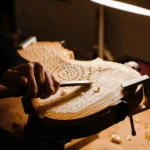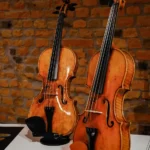The Fine Italian Violin: The Masterpieces Features
Back to BlogItalian violins are well known for their excellent sound. The Italian school of violin making is founded on knowledge accumulated over centuries and passed down from generation to generation via the continuous refinement of classic models and the constant search for new forms and shapes to satisfy the ever-changing needs of players.
Owning a fine old Italian instrument is the dream of many violinists. There is little understanding of the complex issues of provenance, condition, and pricing involved in acquiring one.
Italy has a history with violins, which, through the decades, has resulted in masterpieces
Italian violins, and especially antique Italian violins, which have a long tradition of excellence, show a positive trend as investments. Even during the last years, the price has increased, especially for French bows. During that time, the age of globalization has made the market truly global. Internet sales have also become an integral part of our lives.
In the early 16th century, Italian instrument maker Andrea Amati created the modern four-string violin. His complex geometry and structure set new standards for both visual and acoustic appeal. Violin-making requires a lot of studies to develop skills. Violin schools are important to master the techniques and get professional experience. To become a master (and not just play the violin) it is essential to keep studying and mastering your chosen field.
What outstands in Italian Violins
The country became a reference in violin-making, especially Cremona, the city of the violin. Nowadays, masterpieces are built all over the world by incredible luthiers, but what differs the Italian Violins from others is the tradition and method developed from decades, the very same used by our master makers from the 16th and 17th centuries!
And because of them, the Italian violins have these unique features and high quality, the violin-making knowledge conquered in Italy is recognized worldwide. The tradition of violin-making in Italy goes back centuries. This long history is due to the careful balance between innovation and tradition that has always been a mark of great Italian instruments. Therefore, a violin’s value can be rated according to many factors, but generally speaking, it can be: age, the luthier’s skills and experience, model, size, condition, and authenticity.
If you are new to this world, you notice that the tone is not the key to set the price. People have so much individual taste when it comes to music and instruments, but the tone is crucial to the extent that a great-sounding violin will always sell more quickly and often for a bit of a premium. So take your time, and make sure you have tried enough violins to be sure you have sampled what’s actually available. The handcrafted instruments are at the core of the Italian Violin, therefore the condition and authenticity are very important aspects.
Those who work on old violins know the problems of working with an antique: It’s not uncommon to see cracks in the top, all carefully restored by a specialist. Often, it takes an expert eye to spot the repairs. This takes us to another topic that is violin cares and adjustments, also very important if you want your violin to last more.
Usually, these instruments follow an old master method or the luthiers take it as an inspiration or even as a copy model. Each luthier has a preference and an inspiration that besides complementing their work, makes them unique. This defines the makers’ styles, based on their taste, each one develops its own method, some luthiers will get more inspiration from some old master models or focus only on a personal one.









